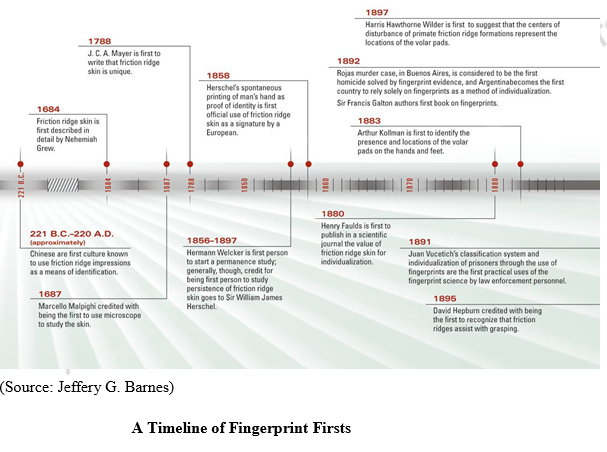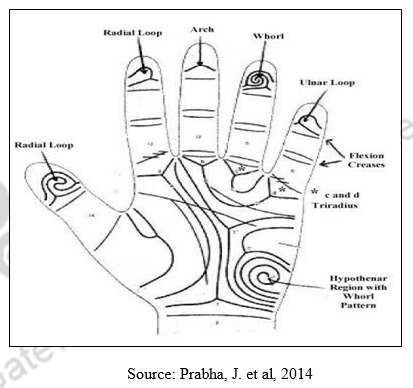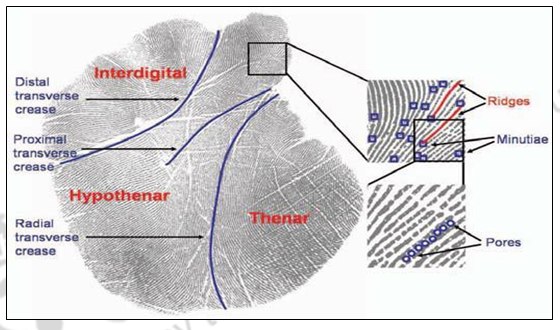18 Palm Prints and Sole Prints, including Foot Marks, details of Ridge and Crease Characteristics
E-L earning: Through this text one will be able to know the different aspect of Dermatoglyphics, palm prints, foot prints and foot marks, ridge and crease characteristics and their importance at the scene of crime or for the court of law to establish the identity of a person.
Text is divided as follows-
- Dermatoglyphics and their historical development
- Types of finger prints pattern
- Palm prints and their study area
- About sole prints, foot prints and foot marks
- Ridge and crease characteristics
- Medico-legal importance of finger prints
The whole human body is covered with skin, which is the most important integument. The skin which covers the anterior surface of human hand and the planter surface of the human foot is different in texture and appearance than the one which covers the rest of the human body. The skin on the palmar and plantar surface is continuously wrinkled with narrow minute ridges (also known as friction ridges) and is also completely free from hair and oil glands. However, there is a profusion of sweat glands and these are relatively large in size. It mainly helps in sense of touch and in providing grip. This ridged skin is not only confined to the plantar and palmar surfaces but identical ridges occur even on the fingers and toes as well. (Kumbnani, 2007;Kiran et al, 2010; Ahmed & Yasin, 2010). The study of ridged skin on fingers, palms, soles and toes is termed as Dermatoglyphics. Etymologically this term dermatoglyphic comes from two Greek words (Derm = Skin and glyphe = carving). Dermal ridge differentiation takes place in the third and fourth month of fetal life. By the end of fourth month, the ridges and their arrangements are in their complete and permanent form (Kumbnani, 2007; Ahmed and Yasin 2010; Manoj kumar et al., 2012). From this time onwards until the death there is no morphological change either in the detailed structure of the ridges or in the patterns formed by them. The fact that each individual‘s ridge configurations are unique has been greatly utilized as a means of personal identification, especially by law enforcement officials. The heritability of certain dermatoglyphic traits is utilized in identifying the twins and in solving questioned paternity.
Fingerprints identified at crime scenes fall into three categories:
- Patent
- Latent
- Impressed
Patent fingerprints are those that are clearly visible to the naked eye and are normally made because the individual has had their fingers in some sort of liquid or powder. Mostly this would be blood, ink, oil or the likes and the fingerprint is clearly visible and a close up photograph is often all that is necessary to record it. Latent fingerprints are prints that are not visible to the naked eye but are visible under certain conditions; they can be made visible – or certainly more identifiable – by introducing them to a powder or chemical agent. Impressed prints are those that have been made in soft material or tissue by pressing down with the finger or hand. These prints can be photographed or in certain circumstances moulds made if they are very fragile.
The earliest scientific descriptions are given by Grew in a report to the Royal Society (I684), by Bidloo (I685) and by Malpighi (i686). The first classification of finger-prints dates back to the famous anatomist Purkinje (I823), but it was not until 1880 that a letter to Nature by Henry Faulds directed attention to the possibility of using the details of ridge configuration for purposes of identification. The pioneer work on morphology, classification, heredity and racial variation was done by Galton, and a fairly voluminous literature on questions of detail has accumulated since. A chapter on the general nature of ridged skin, including its anatomy, the characteristics of single ridges, their constancy throughout life, skin creases, etc., is followed by a major section on methods of printing and the general nature and classification of the patterns on fingers, palms, toes and soles (Cummins and Midlo, 1943)
Types of Finger Prints Pattern
Finger prints may be resolved into four types of patterns. The patterns may be further divided into sub- groups by means of the similar differences existing between the patterns in the same general groups. These divisions are as:
1. Arch: Plain Arch
Tented Arch
2. Loop: Radial Loop
Ulnar Loop
3. Whorl: Plain Whorl
Central Pocket Loop
Double Loop
Accidental Loop
4. Composites:
1. Arch: The ridges of the fingers starts running continuously from one side of the finger and end to the other side. There is no triradius in arch pattern. There are two sub-groups of the arch pattern:
a) Plain Arch- In this pattern, ridges starts on one side of the finger, then cascades upward slightly, almost resembles a wave out on the ocean.
b) Tented Arch- This pattern is similar to the plain arch in that it starts on one side of the finger and flow out in a similar pattern to the other side. However, the difference in the tented arch lies in the ridges in the centre, which are not continuous as in the case of the plain arch.
2. Loop: In this pattern, ridges make a backward turn but do not twist. One triradius is found in loops.
a) Radial Loop- These are the loops that flow toward the radius bone of the hand or the downward slope of the loop is from the direction of the little finger toward the thumb of the hand.
b) Ulnar Loop- These are the loops that flow toward the ulna bone of the hand or the downward slope of the loop is from the direction of the little finger toward the little finger of the hand.
3. Whorl: In this pattern, presence of two triradii is significant feature. Characteristic ridge are courses follow circuits around the core. Another common arrangement is a spiral course. Cores are of various; an island, a short straight ridge, a small circular or ellipse, two inter – locked hook shaped ridges or staples. Whorls are of three types:
a) Symmetrical whorls composed of concentric ridges around the single centre.
b) Whorls with a single centre and spirally arranged ridges turning either on clock – wise or anti clockwise direction.
c) Double loop type whorls with two cores, whorls have two triradii.
4) Composites: These are compound patterns in which two or more designs, each conforming to the general aspect of one of the simpler types, are combined in one pattern area. Two or more triradii are present. There are four types of composites:-
a) Central pocket loops: This is essentially a whorl of reduced size lying in the interior of a pattern area which is constructed mainly as a loop. A central pocket loop is a pattern intermediate between a whorl and a pure loop. Central pocket loop are classed as radial or ulnar according to the open extremity of the loop.
b) Lateral pocket loops: When lines traced from the cores emerge on the same digital margin (radial or ulnar), the configuration is a lateral pocket loop.
c) Twin loops: When lines traced from the cores emerge on the opposite margins, the configuration is a twin loop.
d) Accidentals: These are complex patterns formed by combination of two or more usually unrelated patterns (Henry, 1937).
Palm Prints: Palm prints are studied as follows-
- Configurational areas: The palmar surface is divisible into dermatoglyphic areas or configurational fields. There are mainly six areas – hypothenar, thenar and the four interdigitals. Each of the areas is a topologic unit, its individuality being expressed both by existence in some palms of a discrete pattern and by the characterstic presence of partial boundaries formed by triradii and their radiants.
- Digital triradii: Characteristically, there are four digital triradii normally located in proximal region to the bases of digits, II, III, IV & V. In radio – ulnar sequence, they are named a,b,c and d respectively. The two distal or digital radiants of each triradius embrace the digital area, the zone bounded by these radiants and the most proximal metacarpophalangeal flexion crease. The distal radiants, thus, embrace the base of the digit as they course to the interdigital intervals. The proximal radiant is directed towards the interior of the palm, and when fully traced, this radiant is known as a palmar main line. The four main lines orginating from digital triradii are named in radio – ulnar sequence A, B, C and D. An extra triradius in an interdigital areas is referred to as a’, b’, c’ or d’ according to the digital triradius to which it is closest. Occasionally, a digital triradius is absent with the result that one interdigital triradius may subtend two digits e.g., III & IV or IV & V. If such a triradius lies centrally between two digits (as is common in zygodactyly), it can be termed bc or cd accordingly.
- Interdigital patterns: When all four triradii a,b,c, and d are present, at least one loop on the palm is invariably present. Loops, whorls or vestiges situated in the interdigital areas can be specifically recorded. In the case of loop, the direction of exit at the core can be used to describe the loops as distal or in exceptional cases proximal, ulnar or radial.
- Axial triradius: It is situated most commonly at or very near the proximal margin of the palm, in the interval between the thenar and hypothenar eminences. They may occur, however, as far distal as the centre of the palm. The position of this triradius is subjected to much variation and accepted terminology is determined by its position rather than by the exits of its radiants. A palm may have one, two or three axial triradii or rarely none. The position of the axial triradius is perhaps the single most important feature, because it is distally displayed in many abnormal conditions. Its location may be measured either as a fraction of the total length of the palm or as the atd angle. In the proximal region of the palm, it is simply called t. If the triradius lies near the centre of the palm, it is termed t”. When it is in an intermediate position, it is called t’. An axial triradius which is extremely distally placed e.g., distal to the proximal transverse crease, can be termed t”. In the absence of an axial triradius, the symbol ‘O’ is used, and should there be a question as to the presence of a t, due to incomplete printing, the symbol ‘?’ indicates that the determination cannot be made. When 2 or 3 axial triradii occur they are formulated in proximo – distal order (t t’t”).
- Sole Prints: The impression of a piece of footwear can potentially lead to 3 identifications, of increasing accuracy; a shoe of a certain size, a shoe of a certain make or a specific shoe. The quality of the print will usually dictate which of these is possible. A vague outline is unlikely to provide conclusive evidence, but could offer some information about the size and in some cases the brand of a shoe. A high quality print may reveal defects and shape-differences specific to an individual’s shoe. The most common type of recognition will be that of the shoe’s make and model, due to the availability of this data (from shoe manufacturers), the number of samples and the ability to classify according to identifiable features.
- Foot Prints : The skin pattern of toes and heels are as distinctive and permanent as those of fingers. A fresh foot print of the suspected person is taken and compared with the original. Any peculiarities in the foot, such as flat-foot, supernumerary toes, scars or callosities are likely to be found in the foot print. A foot print produced by walking is usually larger than one produced by standing. The imprint on soft and loose material like sand is smaller than the foot and the imprint produced on mud or clay is larger. Foot prints of newborn infants are used in some maternity hospitals to prevent exchange or substitution of infants.
- Foot Marks: From foot mark, at the scene of crime, by general examination one can ascertain the number of persons involved, their actual movements at the scene and their point of entry. Individual impressions, especially in yielding soil, will indicate the shoe size and approximate weight of the person and any peculiarity of the gait. A partial foot mark may be quiet sufficient to positively identify a shoe. Footmarks are recorded by photography, casts or lifting or by combination. Casts can only be taken when there is a foot mark in depth. As they are three dimensional, they can be easily compared with the suspect’s shoes even by lay persons.
- Ridge and Crease Characteristics : Palm print is a combination of two unique features, namely, the palmar friction ridges and the palmar flexion creases. Palmar friction ridges are the corrugated skin patterns with sweat glands but no hair or oil glands. Discontinuities in the epidermal ridge patterns are called the palmar flexion creases. These are the firmer attachment areas to the basal (dermis) skin structure. Flexion creases appear before the formation of friction ridges during the embryonic skin development stage, and both of these features are claimed to be immutable, permanent, and unique to an individual. The three major types of flexion creases that are most clearly visible are distal transverse, proximal transverse, and radial transverse creases. Based on these major creases, three palm print regions are defined: interdigital, thenar, and hypothenar (Jain and Feng, 2009).
Some of the eminent flexion creases of the palm are the bracelet creases positioned proximally. Radial longitudinal crease, proximal transeverse crease and the distal transeverse crease, respectively. Contrary to the observation of Cummins the present author is of the conviction that the flexion creases are the integral part of palm. The axial triradius of the palm is the most important features of the palm print. To ascertain accurately the levels of it one requires two important creases, namely the bracelet crease and the metacarpophalangeal crease of the fourth digit. Joining both of these creases passing through the most proximal axial triradius and the triradius of the fourth digit and extending it to the metacarpophalangeal crease of the fourth digit, the lower half of this axis provides the basis of various axial triradii, thus ascertaing the position t, t’ & t”, respectively. Some of the flexion creases are also associated with the afflictions of chromosomal aberrations like simian crease. This creases on the distal part of the palm starting from ulnar side continuing to radial side. As such there would be two creases in the palm rather than three as usual. Such a crease is called a simian crease for it is commonly found in simians.
Terms used in dermatoglypics
Cyanoacrylate: The primary (>98%) component of super glue; it is used in a fuming technique to develop latent (invisible) prints on a variety of surfaces so they can be photographed.
Core : A structure in the print that is the center line or lines of the print; it is important for conducting ridge counts.
Delta : A point in loop and whorl prints that lies within an often triangular, three pronged or funnel shaped structure; it is the part of a ridge nearest the point where two parallel ridge lines (the “type” lines) diverge to flow around the loop or whorl; loop patterns have one delta, which is the starting point for conducting a ridge count, and whorls have two or more, which are important for determining the whorl type.
Friction ridge: The raised portion of the skin of the print, consisting of one or more connected ridges.
Furrow: A valley or depression between friction ridges.
Medico-legal Importance of finger prints and palm prints
In personal Identification: finger and palm prints are unique to everyone, so features are studied to identify a person. The chance prints left at the scenes of crime are lifted and compared with the suspected persons and identification of the criminal established.
Disputed Paternity: The prints of the mother, the child and the putitave father are taken in giving the verdict.
Twin Studies: Through finger and palm prints, intensive account of MZ, DZ twins but also other possible rare types of twins can be identified.
Correlated with disease: when cytological examination reveals that the numerical and structurcal, aberrations are correlated with dermatoglyphics. Some of the typical examples are like the high frequency of Ulnar loops in trisomy of group G chromosome, more frequency of Arches in the deletion of short arm of chromo-some 5, high finger ridge count in XXX chromosomes, High value of Main Line Index in trisomy-G.
| you can view video on Palm prints and sole prints, including foot marks, Details of ridge and crease characters |



